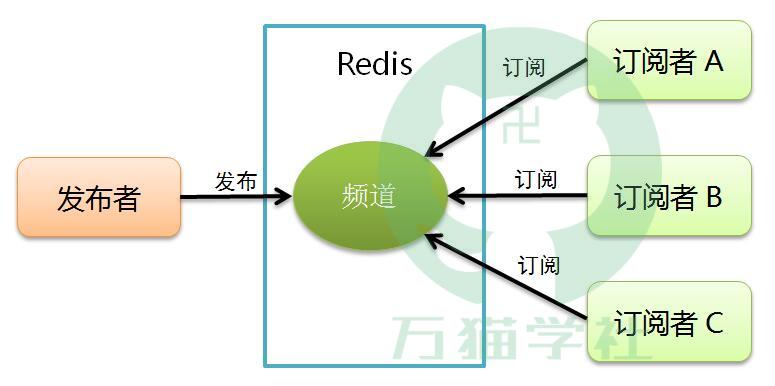Redis教程
最通俗易懂的Redis发布订阅及代码实战
发布订阅简介
除了使用List实现简单的消息队列功能以外,Redis还提供了发布订阅的消息机制。在这种机制下,消息发布者向指定频道(channel)发布消息,消息订阅者可以收到指定频道的消息,同一个频道可以有多个消息订阅者,如下图:
Redis也提供了一些命令支持这个机制,接下来我们详细介绍一下这些命令。
发布订阅相关命令
在Redis中,发布订阅相关命令有:
- 发布消息
- 订阅频道
- 取消订阅
- 按照模式订阅
- 按照模式取消订阅
- 查询订阅信息
发布消息
发布消息的命令是publish,语法是:
publish 频道名称 消息
比如,要向channel:one-more-study:demo频道发布一条消息“I am One More Study.”,命令如下:
> publish channel:one-more-study:demo "I am One More Study." (integer) 0
返回的结果是订阅者的个数,上例中没有订阅者,所以返回结果为0。
订阅消息
订阅消息的命令是subscribe,订阅者可以订阅一个或者多个频道,语法是:
subscribe 频道名称 [频道名称 ...]
比如,订阅一个channel:one-more-study:demo频道,命令如下:
> subscribe channel:one-more-study:demo Reading messages... (press Ctrl-C to quit) 1) "subscribe" 2) "channel:one-more-study:demo" 3) (integer) 1
返回结果中有3条,分别表示:返回值的类型(订阅成功)、订阅的频道名称、目前已订阅的频道数量。当订阅者接受到消息时,就会显示:
1) "message" 2) "channel:one-more-study:demo" 3) "I am One More Study."
同样也是3条结果,分别表示:返回值的类型(信息)、消息来源的频道名称、消息内容。
新开启的订阅者,是无法收到该频道之前的历史消息的,因为Redis没有对发布的消息做持久化。
取消订阅
取消订阅的命令是unsubscribe,可以取消一个或者多个频道的订阅,语法是:
unsubscribe [频道名称 [频道名称 ...]]
比如,取消订阅channel:one-more-study:demo频道,命令如下:
> unsubscribe channel:one-more-study:demo 1) "unsubscribe" 2) "channel:one-more-study:demo" 3) (integer) 0
返回结果中有3条,分别表示:返回值的类型(取消订阅成功)、取消订阅的频道名称、目前已订阅的频道数量。
按模式订阅消息
按模式订阅消息的命令是psubscribe,订阅一个或多个符合给定模式的频道,语法是:
psubscribe 模式 [模式 ...]
每个模式以 * 作为匹配符,比如 channel* 匹配所有以 channel 开头的频道,命令如下:
> psubscribe channel:* Reading messages... (press Ctrl-C to quit) 1) "psubscribe" 2) "channel*" 3) (integer) 1
返回结果中有3条,分别表示:返回值的类型(按模式订阅成功)、订阅的模式、目前已订阅的模式数量。当订阅者接受到消息时,就会显示:
1) "pmessage" 2) "channel*" 3) "channel:one-more-study:demo" 4) "I am One More Study."
返回结果中有4条,分别表示:返回值的类型(信息)、消息匹配的模式、消息来源的频道名称、消息内容。
按模式取消订阅
按模式取消订阅的命令是punsubscribe,可以取消一个或者多个模式的订阅,语法是:
punsubscribe [模式 [模式 ...]]
每个模式以 * 作为匹配符,比如 channel:* 匹配所有以 channel 开头的频道,命令如下:
1> punsubscribe channel:* 1) "punsubscribe" 2) "channel:*" 3) (integer) 0
返回结果中有3条,分别表示:返回值的类型(按模式取消订阅成功)、取消订阅的模式、目前已订阅的模式数量。
查询订阅信息
查看活跃频道
活跃频道指的是至少有一个订阅者的频道,语法是:
pubsub channels [模式]
比如:
> pubsub channels 1) "channel:one-more-study:test" 2) "channel:one-more-study:demo" 3) "channel:demo" > pubsub channels *demo 1) "channel:one-more-study:demo" 2) "channel:demo" > pubsub channels *one-more-study* 1) "channel:one-more-study:test" 2) "channel:one-more-study:demo"
查看频道订阅数
pubsub numsub [频道名称 ...]
比如:
> pubsub numsub channel:one-more-study:demo 1) "channel:one-more-study:demo" 2) (integer) 1
查看模式订阅数
> pubsub numpat (integer) 1
代码实战
光说不练假把式,我们使用Java语言写一个简单的发布订阅示例。
Jedis集群示例
Jedis是Redis官方推荐的Java连接开发工具,我们使用Jedis写一个简单的集群示例。
package onemore.study;
import redis.clients.jedis.HostAndPort;
import redis.clients.jedis.JedisCluster;
import redis.clients.jedis.JedisPoolConfig;
import java.util.HashSet;
import java.util.Set;
/**
* Jedis集群
*
* @author 万猫学社
*/
public enum Cluster {
INSTANCE;
//为了简单,把IP和端口直接写在这里,实际开发中写在配置文件会更好。
private final String hostAndPorts = "192.168.0.60:6379;192.168.0.61:6379;192.168.0.62:6379";
private JedisCluster jedisCluster;
Cluster() {
JedisPoolConfig poolConfig = new JedisPoolConfig();
//最大连接数
poolConfig.setMaxTotal(20);
//最大空闲数
poolConfig.setMaxIdle(10);
//最小空闲数
poolConfig.setMinIdle(2);
//从jedis连接池获取连接时,校验并返回可用的连接
poolConfig.setTestOnBorrow(true);
//把连接放回jedis连接池时,校验并返回可用的连接
poolConfig.setTestOnReturn(true);
Set<HostAndPort> nodes = new HashSet<>();
String[] hosts = hostAndPorts.split(";");
for (String hostport : hosts) {
String[] ipport = hostport.split(":");
String ip = ipport[0];
int port = Integer.parseInt(ipport[1]);
nodes.add(new HostAndPort(ip, port));
}
jedisCluster = new JedisCluster(nodes, 1000, poolConfig);
}
public JedisCluster getJedisCluster() {
return jedisCluster;
}
}
发布者示例
package onemore.study;
import redis.clients.jedis.JedisCluster;
/**
* 发布者
*
* @author 万猫学社
*/
public class Publisher implements Runnable {
private final String CHANNEL_NAME = "channel:one-more-study:demo";
private final String QUIT_COMMAND = "quit";
@Override
public void run() {
JedisCluster jedisCluster = Cluster.INSTANCE.getJedisCluster();
for (int i = 1; i <= 3; i++) {
String message = "第" + i + "消息";
System.out.println(Thread.currentThread().getName() + " 发布:" + message);
jedisCluster.publish(CHANNEL_NAME, message);
try {
Thread.sleep(1000);
} catch (InterruptedException e) {
e.printStackTrace();
}
System.out.println("------------------");
}
jedisCluster.publish(CHANNEL_NAME, QUIT_COMMAND);
}
}
订阅者示例
package onemore.study;
import redis.clients.jedis.JedisCluster;
import redis.clients.jedis.JedisPubSub;
/**
* 订阅者
*
* @author 万猫学社
*/
public class Subscriber implements Runnable {
private final String CHANNEL_NAME = "channel:one-more-study:demo";
private final String QUIT_COMMAND = "quit";
private final JedisPubSub jedisPubSub = new JedisPubSub() {
@Override
public void onMessage(String channel, String message) {
System.out.println(Thread.currentThread().getName() + " 接收:" + message);
if (QUIT_COMMAND.equals(message)) {
unsubscribe(CHANNEL_NAME);
}
}
};
@Override
public void run() {
JedisCluster jedisCluster = Cluster.INSTANCE.getJedisCluster();
jedisCluster.subscribe(jedisPubSub, CHANNEL_NAME);
}
}
综合示例
package onemore.study;
public class App {
public static void main(String[] args) throws InterruptedException {
//创建3个订阅者
new Thread(new Subscriber()).start();
new Thread(new Subscriber()).start();
new Thread(new Subscriber()).start();
Thread.sleep(1000);
//创建发布者
new Thread(new Publisher()).start();
}
}
运行结果如下:
Thread-6 发布:第1消息 Thread-0 接收:第1消息 Thread-1 接收:第1消息 Thread-2 接收:第1消息 ------------------ Thread-6 发布:第2消息 Thread-0 接收:第2消息 Thread-1 接收:第2消息 Thread-2 接收:第2消息 ------------------ Thread-6 发布:第3消息 Thread-0 接收:第3消息 Thread-2 接收:第3消息 Thread-1 接收:第3消息 ------------------ Thread-0 接收:quit Thread-1 接收:quit Thread-2 接收:quit
-
阿里云Redis项目实战入门教程11-08
-
阿里云Redis资料:新手入门与初级使用指南11-08
-
阿里云Redis教程:新手入门及实用指南11-08
-
阿里云Redis学习入门:新手必读指南11-07
-
阿里云Redis学习入门:从零开始的操作指南11-07
-
阿里云Redis学习:初学者指南11-07
-
阿里云Redis入门教程:轻松搭建与使用指南11-06
-
Redis项目实战:新手入门教程11-02
-
Redis入门教程:轻松掌握数据存储与操作10-22
-
Redis缓存入门教程:快速掌握Redis缓存基础知识10-22
-
Redis入门指南:轻松掌握Redis基础操作10-22
-
Redis Quicklist 竟让内存占用狂降50%?10-22
-
Redis学习:从入门到初级应用教程10-17
-
Redis入门:新手必读教程10-12
-
阿里云Redis项目实战:新手入门教程09-26


